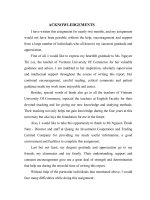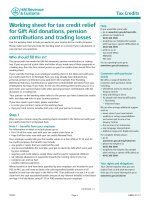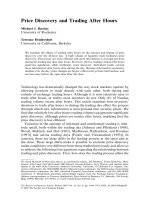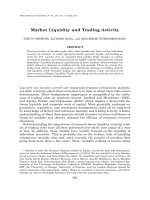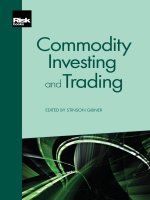Commodity Investing and Trading
Bạn đang xem bản rút gọn của tài liệu. Xem và tải ngay bản đầy đủ của tài liệu tại đây (7.29 MB, 475 trang )
Commodity
EDITED BY STINSON GIBNER
Investing
and
Trading
Commodity Investing and Trading Edited by Stinson Gibner
For some, the trends - and volatility - in
commodity markets in the 21st century
can be summed up in one word: China.
Yet those studying, trading and regulating
these markets know that such deceptively
simple descriptions cannot explain the subtle
dynamics that drive supply and demand.
To be sure, China’s growth, industrialisation
and consumerism have led to soaring demand
for everyday commodities: China now
accounts for over 40% of the demand of the
world’s iron ore, copper, and other metals.
But commodity markets are now part of the
integrated global nancial system - bueted
by demand from growing emerging-market
economies as much as by cash-rich funds
eyeing commodities as an asset class.
Editor Stinson Gibner brings two decades of
experience to Commodity Investing and Trading,
having cut his teeth at Enron, Citadel, and
Citigroup. He has assembled a team of industry
experts whose contributions give the reader
a unique view of the commodity markets.
Chapters focus on the fundamentals
of major, key markets:
• oilandpetroleum
• metals
• naturalgas
• power
• weather
• grainsandoilseeds
• coal.
Subsequent chapters detailing risk management,
trading, and market insights including:
• structuralalphastrategies
• energyindextracking
• enterpriseriskmanagement
• CVAforcommodityderivatives
• thefutureofmarketsinChina.
Contributors include:
Michael Haigh Société Générale,
Kamal Naqvi Credit Suisse,
Mark Hooker State Street Global Advisors,
Carlos Blanco NQuantX, LLC and
Wang Xueqin Zhengzhou Commodity Exchange.
Commodity markets are an indelible
element of nancial markets and of society.
For thousands of years they have shown
themselves to be the most ecient way to
assign the elemental resources
necessary to advance. This fundamental
quality has not changed.
What has changed is the breadth,
depth and complexity of markets.
PEFC Certified
This book has been
produced entirely from
sustainable papers that
are accredited as PEFC
compliant.
www.pefc.org
Commodity Investing and Trading.indd 1 01/10/2013 15:36
Commodity Investing and Trading
00 Prelims CIT_Commodity Investing and Trading 26/09/2013 11:30 Page i
00 Prelims CIT_Commodity Investing and Trading 26/09/2013 11:30 Page ii
Commodity Investing and Trading
Stinson Gibner
00 Prelims CIT_Commodity Investing and Trading 26/09/2013 11:30 Page iii
Published by Risk Books, a Division of Incisive Media Investments Ltd
Incisive Media
3
2–34 Broadwick Street
L
ondon W1A 2HG
Tel: +44(0) 20 7316 9000
E
-mail:
Sites: www.riskbooks.com
w
ww.incisivemedia.com
© 2013 Incisive Media
ISBN 978 1 906348 84 7
B
ritish Library Cataloguing in Publication Data
A catalogue record for this book is available from the British Library
Publisher: Nick Carver
Associate Editor: Alice Levick
Managing Editor: Lewis O’Sullivan
Designer: Lisa Ling
Copy-edited by Laurie Donaldson
Typeset by Mark Heslington Ltd, Scarborough, North Yorkshire
Printed and bound in the UK by Berforts Group Ltd
Conditions of sale
All rights reserved. No part of this publication may be reproduced in any material form whether
by photocopying or storing in any medium by electronic means whether or not transiently or
incidentally to some other use for this publication without the prior written consent of the
copyright owner except in accordance with the provisions of the Copyright, Designs and Patents
Act 1988 or under the terms of a licence issued by the Copyright Licensing Agency Limited of
Saffron House, 6–10 Kirby Street, London EC1N 8TS, UK.
Warning: the doing of any unauthorised act in relation to this work may result in both civil and
criminal liability.
Every effort has been made to ensure the accuracy of the text at the time of publication, this
includes efforts to contact each author to ensure the accuracy of their details at publication is
correct. However, no responsibility for loss occasioned to any person acting or refraining from
acting as a result of the material contained in this publication will be accepted by the copyright
owner, the editor, the authors or Incisive Media.
Many of the product names contained in this publication are registered trade marks, and Risk
Books has made every effort to print them with the capitalisation and punctuation used by the
trademark owner. For reasons of textual clarity, it is not our house style to use symbols such as
TM, ®, etc. However, the absence of such symbols should not be taken to indicate absence of
trademark protection; anyone wishing to use product names in the public domain should first
clear such use with the product owner.
While best efforts have been intended for the preparation of this book, neither the publisher, the
editor nor any of the potentially implicitly affiliated organisations accept responsibility for any
errors, mistakes and or omissions it may provide or for any losses howsoever arising from or in
reliance upon its information, meanings and interpretations by any parties.
00 Prelims CIT_Commodity Investing and Trading 26/09/2013 11:30 Page iv
About the Editors ix
About the Authors xi
Introduction xvii
PART I: COMMODITY MARKET FUNDAMENTALS
1 The Impact of Non-fundamental Information on Commodity
Markets 3
Michael S. Haigh
Société Générale Corporate and Investment Bank
2 The North American Natural Gas Market 25
Stinson Gibner
Whiteside Energy
3 A Day in the Life of Commodity Weather 65
Jose Marquez
Whiteside Energy
4 Oil and Petroleum Products: History and Fundamentals 75
Todd J. Gross
QERI LLC
5 Wholesale Power Markets 113
William Webster
RWE Supply and Trading
6 The Metals Markets 133
Kamal Naqvi
Credit Suisse
Contents
00 Prelims CIT_Commodity Investing and Trading 26/09/2013 11:30 Page v
7 Grains and Oilseeds 165
David Stack
Agrimax
8 Coal 207
Jay Gottlieb
PART II: TRADING AND INVESTMENT STRATEGIES
9 Farmland as an Investment 229
Greyson S. Colvin and T. Marc Schober
Colvin & Co. LLP
10 Agriculture Trading 249
Patrick O’Hern
Sugar Creek Investment Management
11 Quantitative Approaches to Capturing Commodity Risk
Premiums 295
Mark Hooker and Paul Lucek
State Street Global Advisors and SSARIS Advisors
12 Structural Alpha Strategies 307
Francisco Blanch; Gustavo Soares and Paul D. Kaplan
Bank of America Merrill Lynch; Macquarie Funding
Holding Inc. and Morningstar, Inc.
13 Energy Index Tracking 337
Kostas Andriosopoulos
ESCP Europe Business School
PART III: MARKET DEVELOPMENTS AND RISK MANAGEMENT
14 Enterprise Risk Management for Energy and Commodity
Physical and Financial Portfolios 371
Carlos Blanco
NQuantX LLC and MTG Capital Management
COMMODITY INVESTING AND TRADING
vi
00 Prelims CIT_Commodity Investing and Trading 26/09/2013 11:30 Page vi
15 Credit Valuation Adjustment (CVA) for Energy and
Commodity Derivatives 389
Carlos Blanco; and Michael Pierce
NQuantX LLC and MTG Capital Management; NQuantX LLC
16 The Past, Present and Future of China’s Futures Market:
Trading Volume Analysis 409
Wang Xueqin
Zhengzhou Commodity Exchange
Index 439
CONTENTS
vii
00 Prelims CIT_Commodity Investing and Trading 26/09/2013 11:30 Page vii
00 Prelims CIT_Commodity Investing and Trading 26/09/2013 11:30 Page viii
Stinson Gibner is an analyst at Whiteside Energy, having worked in
energy risk management and trading since the early 1990s. He previ-
ously headed the quantitative analytics team as a managing director
for Citigroup Global Commodities, supporting offices in Houston,
London and Singapore. Before joining Citigroup in 2005, Stinson
served as a director at Citadel Investment Group LLC, where he was
responsible for developing models and systems used for energy
trading and risk management. Between 1992 and 2001, he worked in
the quantitative modelling group at Enron Corp. Stinson received his
BA in physics from Rice University and a PhD from Caltech.
ix
About the Editor
00 Prelims CIT_Commodity Investing and Trading 26/09/2013 11:30 Page ix
00 Prelims CIT_Commodity Investing and Trading 26/09/2013 11:30 Page x
Kostas Andriosopoulos is executive director of the Research Centre
for Energy Management at ESCP Europe Business School. His
research interests include price modelling, financial engineering and
the application of risk management techniques and innovative
investment strategies in energy, shipping and agricultural commodi-
ties markets, and international trade. Kostas is the associate editor for
the International Journal of Financial Engineering and Risk Management
and has organised numerous international conferences. He holds a
PhD in finance from Cass Business School, London, an MBA and
MSc in finance from Northeastern University, Boston, and a bach-
elor’s degree in production engineering and management from the
Technical University of Crete, Greece.
Francisco G. Blanch is managing director and head of global
commodities and derivatives research at Bank of America Merrill
Lynch, where he is also a member of the research investment and
executive management committees. Prior to joining Merrill Lynch,
he was an energy economist at Goldman Sachs and consulted for the
European Commission. Francisco holds a doctorate in economics
from Complutense University of Madrid and a masters in public
administration from Harvard University, where he was also a
teaching fellow in financial markets.
Carlos Blanco is managing director of NQuantX LLC, and director of
risk management at MTG Capital. He is also a faculty member at The
Oxford Princeton Programme, where he heads the Certificate
Programme on Derivatives Pricing, Hedging and Risk Management.
Greyson S. Colvin is founder and managing partner of Colvin & Co,
an agriculture- focused investment manager. Previously, he was a
research analyst at Credit Suisse in the Portfolio Management Group
and at UBS Investment Research. Greyson has been featured in
xi
About the Authors
00 Prelims CIT_Commodity Investing and Trading 26/09/2013 11:30 Page xi
numerous publications and is co- author of the Investors’ Guide to
Farmland. He received a BA in financial management from the
University of St. Thomas and an MBA in finance and investment
banking from the University of Wisconsin, Madison.
Rita D’Ecclesia is a professor at Sapienza University of Rome and
visiting professor at Birkbeck College, University of London. She is
also a director of the PhD programme in Economics and Finance at
Sapienza, as well as the director of the International Summer School
on Risk Measurement and Control, chair of the Euro Working Group
for Commodities and Financial Modeling and associate editor of
several scientific journals. Rita teaches courses at graduate and PhD
levels on quantitative models, finance and asset pricing. Rita's
research activity focuses on optimisation techniques and modelling
financial and energy commodity markets. She is active within the
Research Centre for Energy Management at ESCP Europe.
Jay Gottlieb led development of the first coal derivatives instru-
ment, the NYMEX CAPP coal futures contract, while a director in the
Exchange's Research Department. Jay was also instrumental in the
launch of instruments and over the counter clearing for the electricity
and emissions markets, and exchange traded funds for gold and oil
markets. He has served as a member of the board of directors of the
New York State Energy Research and Development Authority and
the Coal Trade Association. He holds an MBA from Stanford, a BS
from Huxley College of the Environment, and a BA from St. John's
College, Annapolis.
Todd Gross is chief investment officer, managing member and
founder of QERI LLC, a New York commodity trading firm which
invests client assets in liquid, fundamentally-based strategies.
Throughout a 25-year career Todd has been dedicated to under-
standing the nuances and inefficiencies of the commodity space with
particular emphasis in Energy. He began his career at Cooper Neff &
Associates, moved on to manage derivatives in Morgan Stanley's
Global Commodity Group, and founded and ran Hudson Capital
Group LLC, before launching QERI LLC in 2012. Todd received a BS
in economics from Wharton and a bachelor of applied science in
systems engineering from the Moore School of Engineering.
COMMODITY INVESTING AND TRADING
xii
00 Prelims CIT_Commodity Investing and Trading 26/09/2013 11:30 Page xii
Michael Haigh is managing director and global head of commodi-
ties research for Société Générale, based in New York City, managing
a team of commodity analysts in Singapore, Paris, London and New
York City. Prior to joining Société Générale, he was global head of
commodities research at Standard Chartered Bank in Singapore.
Michael has also held the position of managing director at K2
Advisors, and spent several years as the associate chief economist at
the US Commodity Futures Trading Commission and as a tenured
associate professor of economics at the University of Maryland. He
holds a PhD in economics with a minor in statistics from North
Carolina State University.
Mark Hooker was most recently senior managing director of State
Street Global Advisors and head of its Advanced Research Center,
where he was responsible for the worldwide development and
enhancement of SSgA’s quantitative investment models. Prior to
joining SSgA in 2000, Mark was a financial economist with the
Federal Reserve Board in Washington, and before that an assistant
professor of economics at Dartmouth College. He earned a PhD in
economics from Stanford University and a bachelor’s degree with a
dual concentration in economics and mathematics from the
University of California at Santa Barbara.
Paul D. Kaplan is director of research for Morningstar Canada and a
senior member of Morningstar’s global research team, as well as a
qualified CFA. He is responsible for many of the quantitative
methodologies behind Morningstar’s fund analysis, indexes, advisor
tools and other services. Paul’s research has appeared in many
professional publications, including his book, Frontiers of Modern
Asset Allocation. He received his bachelor’s degree from New York
University and his masters and doctorate in economics from
Northwestern University.
Paul R. Lucek is the chief investment officer, Hedge Fund Group,
and a member of the Hedge Fund Investment Committee at SSARIS
Advisors. Prior to joining SSARIS, he developed quantitative algo-
rithms for trading stock index futures, and in 1996 he co- founded
SITE Capital Management. He made the transition to money
management from the MD/PhD programme at Columbia
ABOUT THE AUTHORS
xiii
00 Prelims CIT_Commodity Investing and Trading 26/09/2013 11:30 Page xiii
University, College of Physicians and Surgeons, where as a
researcher he pioneered the use of neural networks in the analysis of
complex genetic inheritance in humans. Paul earned his bachelor’s
and master’s degrees in biology from Harvard University, and a
master’s degree in genetics from Columbia University.
Jose Marquez is a meteorologist for Whiteside Energy. Since 2000,
his meteorology experience has been focused on the energy industry,
where he has held positions as senior meteorologist at Total Gas &
Power, Citigroup, Citadel Investment Group and Enron North
America. After graduating from the Navy’s Meteorological and
Oceanographic training school, he served in the US Navy, and he
was also director of meteorology for the Latin America Weather
Channel. He has a BS in environmental sciences from the University
of Puerto Rico and an MS in atmospheric sciences from the Georgia
Institute of Technology.
Kamal Naqvi is a managing director, global head of metals and head
of commodity sales across Europe, the Middle East and Africa in the
investment banking division of Credit Suisse, based in London. He
has been working in the resources industry since the early 1990s,
having also worked in commodity sales and commodity research
positions at Barclays Capital, Macquarie Bank and the Tasmanian
State Government. Kamal holds degrees in law and in economics
(hons) from the University of Tasmania.
Patrick E. O'Hern is the managing partner and co-founder of Sugar
Creek Investment Management, an actively managed commodity
trading and alternative investments advisor in Chicago. Patrick is
also head of portfolio management for the Meech Lake Investment
Group, a commodity trading asset manager. Previously, Patrick
held the position of senior analyst in the funds group at FourWinds
Capital Management in Boston. Prior to joining FourWinds Patrick
spent his early career in trading and brokerage on the floor of the
Chicago Mercantile Exchange, where he traded in the livestock and
dairy pits. Patrick has a bachelor's degree in agriculture business
from Western Illinois University.
COMMODITY INVESTING AND TRADING
xiv
00 Prelims CIT_Commodity Investing and Trading 26/09/2013 11:30 Page xiv
Michael Pierce is co-founder and director of Financial Engineering
at NQuantX LLC a financial engineering firm which develops soft-
ware for portfolio valuation and risk management. He also worked
with Platts as the lead financial engineer and analytics software
developer. He is a former senior financial engineer at Financial
Engineering Associates (a MSCI/Barra company), where he was
responsible for front-line development of numerous software prod-
ucts over an eight-year period. Michael has a master's degree in
mathematics from the University of California at Berkeley.
T. Marc Schober is a director at Colvin & Co and managing editor of
“Farmland Forecast”. He has been featured in numerous publica-
tions and is co- author of the Investors’ Guide to Farmland. Growing up
on a Wisconsin farm, the Schober family has owned and managed
farmland in Wisconsin for over 40 years. He received a BS in business
management from the University of Wisconsin, Eau Claire, and is
also involved in a number of cancer fundraisers, including the
Oconomowoc LakeWalk.
Gustavo Soares is part of the Commodity Investor Products Group
at Macquarie Bank, where he is responsible for designing investable
strategies and indexes in commodities. He joined Macquarie in 2012,
having spent several years at Bank of America Merrill Lynch
working as a commodity strategist. Gustavo holds a BA/MA in
economics from Universidade de São Paulo, Brazil and a PhD in
economics from Yale University.
David G. Stack is managing director of Agrimax, a commodity
market consulting firm. He has worked in the commodities industry
since the late 1980s on all aspects of the energy and agricultural
markets. David is experienced in all parts of the physical and finan-
cial space, and specialises in derivatives, with clients ranging from
the smallest producer to the largest consumer, including hedge
funds and NGOs. Having previously worked at Barclays, Louis
Dreyfus, Bunge, Enron and BP, he is also MD of the Commodity
Trading Room at ESCP Europe, and develops trading and risk
management software with riskGRID.
INTRODUCTION
xv
00 Prelims CIT_Commodity Investing and Trading 26/09/2013 11:30 Page xv
William Webster is head of EU power market design for RWE
Supply and Trading. He began his career in the UK Government
Economic Service, ending with a period at UK water regulator
Ofwat, where he was a team leader. William joined the European
Commission in 2000, working in both DG Energy and Competition,
and introduced competition into electricity and gas markets. In 2007,
he joined RWE and ran two major strategy projects for RWE power
before starting his current role in 2010. William read economics at
Cambridge University, has an MA from the College of Europe and is
a member of the Chartered Institute for Securities and Investment.
Wang Xueqin is a senior specialist of the Zhengzhou Commodity
Exchange, where his major research areas are market development,
new products and commodity options. He previously worked for
the International Department of China Securities Regulatory
Commission, as well as the working taskforce for China’s prepara-
tions for launching CIS 300 at CFFEX. Wang was the first from
China’s futures industry to research options as a visiting scholar at
CBOE and IIT, and he has worked for Zhengzhou Grain Wholesale
Market, the precursor of the China Zhengzhou Commodity
Exchange.
COMMODITY INVESTING AND TRADING
xvi
00 Prelims CIT_Commodity Investing and Trading 26/09/2013 11:30 Page xvi
Strong gains in commodity prices since the early 2000s created a
growing interest in the asset class. The financial industry responded
with many products, including new hedge funds, index funds,
commodity- linked fixed income products and exchange- traded
funds (ETFs). With oil and natural gas making a prominent peak in
2008 and gold hitting a peak in 2011, many took this as a sign that the
commodity bull had run its course and expected that we would
return to the normal long- standing trend of commodity price defla-
tion.
The deflationist camp notes that growth in China must slow
down, possibly to a dramatic degree, if imbalances in that economy
are not handled carefully. Europe and the US continue their struggle
to reignite sorely needed jobs growth in order to relieve high youth
unemployment, while at the same time facing demographics that
lead to a shrinking labour force.
However the world’s economic situation is resolved, commodities
and commodity flows will remain critical to the functioning of cities,
states and economies. For this reason, a basic knowledge of the
supply and demand issues relevant to each commodity sector
provides financial insights even beyond the commodity markets.
This book therefore discusses the fundamentals of many of the major
traded commodities offering both an introduction and a reference
for all those interested in understanding and analysing these
markets.
This book is divided into three sections. The first covers the funda-
mentals of the most important markets in energy, metals and
xvii
Introduction
Stinson Gibner
Whiteside Energy
00 Prelims CIT_Commodity Investing and Trading 26/09/2013 11:30 Page xvii
agriculture. Michael S. Haigh starts us off with an investigation into
the importance of non- fundamental information. He uses principle
component analysis to discover how commodity market behaviour
has changed over the years, and shows evidence that commodity
market participants have adjusted their behaviour since the financial
crisis of 2007–08.
Within the energy complex, crude oil, European power, North
American power, natural gas, liquefied natural gas (LNG), and coal
are covered in separate chapters. Chapter 2 by Stinson Gibner
provides an introduction to the fundamentals of the North American
market for natural gas. Natural and economic forces impacting
supply are illustrated along with the annual rollercoaster of demand.
The critical role of storage in balancing short- term and seasonal
swings is explained, and key issues for the supply–demand balance
are discussed. Also within this chapter, Rita D'Ecclasia gives an
overview of the expanding global LNG trade.
Relevant to all commodities, Jose Marquez discusses weather and
climate from the unique perspective of a working commodities mete-
orologist. His chapter walks through the daily analysis and
information flow that must be monitored to keep abreast of weather
impacts on commodity demand and supply, while a panel discusses
climatology and its longer- term indicators of weather trends.
In Chapter 4, Todd Gross tells the incredible story of how oil prices
climbed from US$17/bbl in 2002 to an amazing US$147/bbl a mere
six years later. Todd also examines, as he puts it, “why the globe
always seems to be running out of oil, and yet, so far, that fate has yet
to be realised.” Unafraid of digging into the details, the analysis of
global refining capacity gives a great insight into the changing
demand for – and flows of – various types of crude. The impact of
transport bottlenecks within North America is also discussed.
William Webster then explains the unique challenges of operating
a market for power, and explores the solution adopted by the
European power market. He explains the instruments traded and
price formation, before offering a historical perspective of pricing for
these markets. He concludes with thoughts about possible future
market trends and regulatory changes.
Kamal Naqvi takes us on a whirlwind tour through the precious,
base and industrial metals in Chapter 6, in which he discusses the
key drivers for metals and offers insights as to which may outper-
COMMODITY INVESTING AND TRADING
xviii
00 Prelims CIT_Commodity Investing and Trading 26/09/2013 11:30 Page xviii
form going forward. In Chapter 7, David Stack provides a tour de
force discussion of the global grains markets, giving an overview of
the markets for food grains, feed grains and oilseeds. Farming area,
yield and production trends are discussed for major producers. The
chapter also reviews past import and export flows, as well as likely
future trends for global grain flows and crop rotation flexibility. A
discussion of the coal markets in Chapter 8 completes the energy
commodities. Jay Gottlieb lays out the fundamentals of the coal
markets and discusses which trends are likely to dominate going
forward.
Rounding out agricultural investments, Greyson Colvin and Marc
Schober open the second section of the book by explaining the basics
of agricultural land in Chapter 9, arguing that the fundamentals
behind the rush to invest in farmland are likely to persist far into the
future. Complementing the grains discussion, Chapter 10 by Patrick
O’Hern explores the agricultural trading and hedging markets and
gives an overview of the types of participants active. He provides
several examples of trading strategies to illustrate intra- market and
cross- market trade opportunities within the agriculture markets,
and illustrates the diversification that may be provided across
commodities.
The remainder of the section on trading and investing strategies
focuses on alpha strategies and index investing. In Chapter 11, Mark
Hooker and Paul Lucek present an interesting case study of what
they call convergent and divergent strategies, concluding that useful
risk diversification can be achieved through intelligent choice of
strategies within a commodity portfolio. An overview of alpha
strategies that could be used by either traders or index funds is given
by Francisco Blanch and Gustavo Soares in Chapter 12, which covers
momentum, roll yield and volatility methods. The accompanying
panel by Paul Kaplan gives a short case study of active index funds
applying these alpha concepts.
In Chapter 13, Kostas Andriosopoulos finishes out the commodity
index investing discussion by bridging the gap between commodi-
ties and equities. It presents his proposal to track a spot commodity
index by using a carefully selected portfolio of equities, and shows
his tested selection methods and tracking results.
The third section of the book opens with two chapters by Carlos
Blanco. In Chapter 15, Blanco and Michael Pierce present the choices
INTRODUCTION
xix
00 Prelims CIT_Commodity Investing and Trading 26/09/2013 11:30 Page xix
for performing a proper analysis of credit risks embedded in your
bilateral trade portfolio. The resulting credit value adjustment (CVA)
provides a measure of expected future loss due to credit events.
Taking a broader view of risk, Chapter 14, also written by Carlos
Blanco, explains the structure for putting in place a system of enter-
prise risk management and some possible pitfalls. In principle,
everyone wants to have proper risk systems and structures in place;
however, operational weakness is difficult to avoid as daily choices
must be made between risk levels and the potential profitability of
the enterprise. Carlos explains the challenges of the risk manager
and offers advice about properly structuring a risk management
function.
Wang Xueqin then reviews the rapid growth of commodities
trading in China in Chapter 16, and shows that although still largely
restricted to domestic participants, the size of China’s commodity
futures markets now rivals commodity markets globally.
COMMODITY INVESTING AND TRADING
xx
00 Prelims CIT_Commodity Investing and Trading 26/09/2013 11:30 Page xx
Part I
Commodity Market
Fundamentals
01 Chapter CIT_Commodity Investing and Trading 25/09/2013 15:43 Page 1
01 Chapter CIT_Commodity Investing and Trading 25/09/2013 15:43 Page 2
Commodity markets can (and will) occasionally co- move with
broader macro markets for reasons beyond the physical fundamen-
tals. The purpose of this chapter is to illustrate how different
commodities are affected by non- fundamental factors (macro shocks,
liquidity events, currency moves and broader market sentiment
swings) that are normally considered exogenous to commodity
fundamentals (eg, mine or oil supply). At certain points in time, espe-
cially since the Lehman bankruptcy in September 2008, the
non- fundamental influences on certain commodities have dwarfed
the impact of actual commodity fundamentals. Accordingly, under-
standing this has brought obvious benefits for analysing how
commodity market price moves can be applied to trading strategies.
The chapter will examine this by focusing on energy (oil), base metals
(copper) and precious metals (gold), and agriculture (soybeans).
Until the late 1990s, commodity markets generally enjoyed excess
capacity as innovations and new discoveries resulted in greater
supply (think of how the US natural gas markets have evolved). Any
supply side shock that was persistent would result in commodity
price increases, higher inflation and a consequent decline in equity
markets: hence the negative relationship with commodity price
movements. However, by 2000, increased demand growth and
underinvestment in the supply chain meant the excess capacity was
slowly absorbed. By 2008, the underinvestment in activity became
more evident as the credit crisis resulted in suspensions and cancella-
3
1
The Impact of Non- fundamental
Information on Commodity Markets
Michael S. Haigh
Société Générale Corporate and Investment Bank
01 Chapter CIT_Commodity Investing and Trading 25/09/2013 15:43 Page 3
tions of hundreds of commodity projects. As such, changes in global
economic activity, Purchasing Manager’s Index(PMI)strength,dollar
strength and changes in inflation expectations (resulting from quanti-
tative easing) are playing a much larger role in commodities.
Given the increased influence of “non- fundamental” information
on commodity markets, it is worthwhile to quantify as accurately as
possible the level of this influence, across commodities and across
time. To thoroughly assess the role of non- fundamentals during
episodes of quantitative easing, we employ the principal component
analysis (PCA) technique. Simply stated, PCA is the analysis of the
covariance matrix and can be used to analyse multi- assets: baskets
made up of commodities, other financial indicators, volatilities, etc.
From the historical data, the analysis determines the principal
components of the covariance matrix – ie, the way in which the asset
price movements correlate, by order of importance. To conduct PCA
on commodity prices, we analyse price data for a variety of
commodities against a diversified basket of 28 assets across markets,
including: volatility indexes (EU and US), credit (EU and US and HY
versus IG), FX (dollar, yen, euro, carry trade (G10 and EM)), bonds
(spreads, 10Y GVT and inflation break- even), equities (BRIC, Euro,
emerging, EU and US) and global indexes. Factors are estimated
using the 28-member basket, which means each factor is a weighted
average of the 28 assets with different weights for each factor.
The model estimated three main explanatory factors: macro,
dollar and liquidity. What is not explained by these factors (the resid-
uals) is interpreted as the commodity fundamentals. Depending on
the commodity, the relative importance of each factor varies consid-
erably, as does the influence on commodities of all the factors
combined. Moreover, extreme events (eg, Lehman Brother’s bank-
ruptcy) have structurally altered the influence of the macro factor (in
particular) and largely demoted the dollar factor to a secondary
“outside” influence on the commodity markets.
Energy
Here we focus on Brent and note that, unsurprisingly, Brent’s funda-
mentals in terms of explanatory power began to deteriorate
(consistently) in 2007 when the subprime crisis became a reality (see
Figure 1.1). In the early 2000s, fundamentals prevailed with 80–90%
explanatory power (eg, in March 2002, dollar and liquidity explained
COMMODITY INVESTING AND TRADING
4
01 Chapter CIT_Commodity Investing and Trading 25/09/2013 15:43 Page 4

